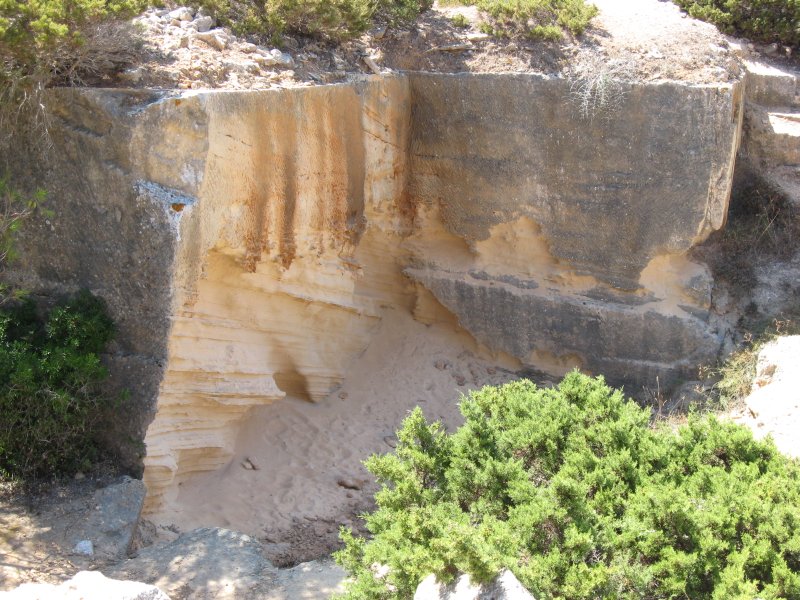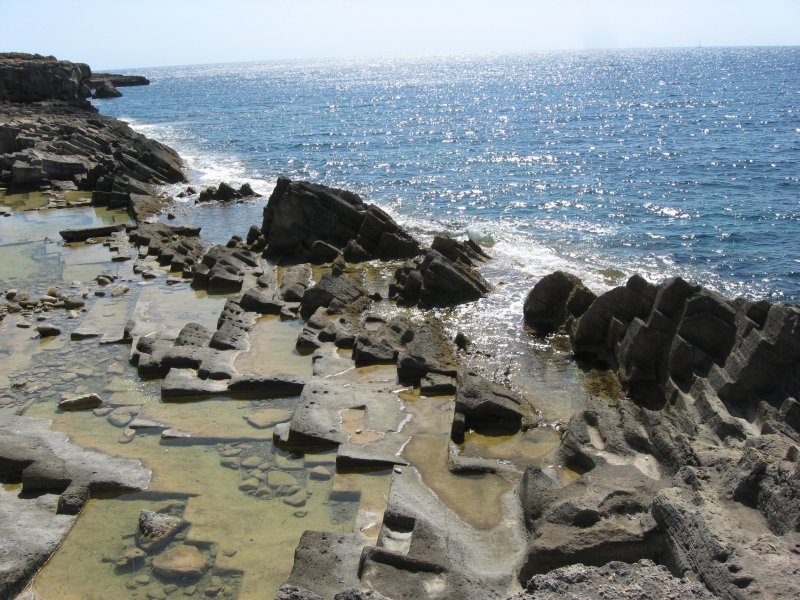 |
English version (German version below): |
This earthcache leads you to an old Marès quarry lying
directly at the coast in Punta de n’Amer. Marès is the local
name of a special sand-lime brick. It is a stone which you can find
on Balearic Islands naturally, but it also exists a synthetic way
to produce the stone. The Marès is often used on the Balearic
Islands for building activities. For example the nearby Castell de
sa Punta de n’Amer (N39° 34.798 E3° 23.766) was built by
using Marès stones. Another example is the famous cathedral La Seu
(N39° 34.053 E3° 38.890) in Palma.
Active Marès querries can be found in Arenal, Muro, Porreres,
Santanyí, Felanitx, Petra and Llucmajor. The Marès out of the
different regions differs from each other regarding hardness and
colouring. The following types can be identified: Acopinyat,
Brossenc de grano grande, Grá de figa, Granat, Picador and
Roget.
In general a sandstone like the Marès is a sedimentary rock
composed mainly of sand-size mineral or rock grains. Most sandstone
is composed of quartz and/or feldspar because these are the most
common minerals in the Earth's crust. Like sand, sandstone may be
any color, but the most common colors are tan, brown, yellow, red,
gray and white. Since sandstone beds often form highly visible
cliffs and other topographic features, certain colors of sandstone
have been strongly identified with certain regions.
Some sandstones are resistant to weathering, yet are easy to work.
This makes sandstone a common building and paving material.
However, some that have been used in the past, such as the
Collyhurst sandstone used in the north of England, have been found
less resistant, necessitating repair and replacement in older
buildings. Because of the hardness of the individual grains,
uniformity of grain size and friability of their structure, some
types of sandstone are excellent materials from which to make
grindstones, for sharpening blades and other implements.
Non-friable sandstone can be used to make grindstones for grinding
grain, e.g., gritstone.

Zum Vergrößern bitte Anklicken / click for
enlargement
To
log this earthcache, perform the following tasks:
- Go
to N39° 34.610 E3° 23.504. There please take optional a photo of
you in front of the Marès quarry. If you are there without any
help, you can take a photo of your GPSr with readable coordinates
instead.
- Go
also to N39° 34.623 E3° 23.532. There you can see very good how the
Marès looks like. Go to the location on the following picture and
find out how the Marès look and feel. Send me your
impressions!

Zum Vergrößern bitte Anklicken / click for
enlargement
 |
Deutsche Version: |
Dieser Earthcache führt Dich zu einem alten Marès Steinbruch
direkt an der Meeresküste in Punta de n’Amer. Marés ist die
lokale Bezeichnung eines Kalksandsteines. Er kommt als natürlicher
Stein auf den Balearen vor, wird aber auch künstlich hergestellt.
Anwendung fanden die Steine für Innen- und Außenwände. Sie sind
vergleichsweise schwer (hohe Dichteklasse), gut schalldämmend und
Wärme speichernd. Marés nehmen beim Verarbeiten viel Feuchtigkeit
auf die somit auch vorübergehend gespeichert werden kann. Beispiele
für die Verwendung von Marès als Baumaterial ist das naheliegende
Castell de sa Punta de n’Amer (N39°
34.798 E3° 23.766) oder die berühmte Kathedrale La Seu
(N39° 34.053 E3° 38.890) in Palma.
Aktive Marès Steinbrüche auf Mallorca finden sich in Arenal, Muro,
Porreres, Santanyí, Felanitx, Petra und Llucmajor. Die in den
verschiedenen Regionen abgebauten Steine zeichneten sich durch
unterschiedliche Härten und Farbgebungen aus und konnten damit den
entsprechenden Orten zugeordnet werden.
Allgemein bezeichnet der Begriff Kalksandstein natürlich
vorkommende Sandstein-Arten, meist jedoch künstlich hergestellte
Mauersteine aus Sand und Calciumcarbonat bzw. Calciumsilikathydrat
als Bindemittel. Bei künstlich hergestellten Kalksandsteinen ist
das Bindemittel nicht Calciumcarbonat, sondern ein durch
Dampfhärtung erzeugtes Calciumsilikathydrat. Im Bauwesen bezeichnet
der Begriff Kalksandstein in der Regel diese künstlich
hergestellten Kalksandsteine (KS), die üblicherweise als
Mauersteine angeboten werden.

Zum Vergrößern bitte Anklicken / click for
enlargement
Um
diesen Earthcache zu loggen, erfülle bitte folgende
Aufgaben:
- Gehe zu N39° 34.610 E3° 23.504. Mache hier bitte freiwillig
ein Foto von Dir vor dem Steinbruch. Falls du alleine bist, reicht
auch ein Foto von deinem GPS mit lesbaren
Koordinaten.
- Gehen nun zu N39° 34.623 E3° 23.532. Dort siehst Du den Ort,
den nachfolgendes Foto zeigt. Gehe dorthin und finde heraus wie
sich Marès anfühlt und wie er aussieht. Sende mir Deine Eindrücke
per Mail.

Zum Vergrößern bitte Anklicken / click for
enlargement
